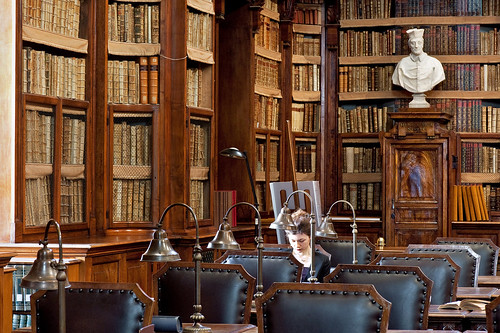
PREV ARTICLE
NEXT ARTICLE
FULL ISSUE
PREV FULL ISSUE
HIDDEN TREASURES IN ITALIAN LIBRARIES
Harry Waterson writes: May I bring your readers' attention to the front page story of the Travel Section of the Sunday New York Times (6/18/17). The first four paragraphs by David Laskin are maybe the best I have every read on the magic of the library. The article is well illustrated but disappoints because having set me up in the beginning, it never shows me the magic of the Marciana. The pictures of Italian libraries that illustrate the article are wonderful but do not make up for the lack of the one image Laskin set me up for.
The article nevertheless presents some great advice for tourists abroad, and one doesn't have to be a bibliophile to benefit. The magnificent buildings can be a joy in themselves, and are usually far from the usual madding crowd of fellow tourists. Off the beaten path lie many overlooked treasures.
-Editor
In the madness of late spring at San Marco Square in Venice, amid the hordes pouring in from land and sea, hard by the hissing espresso machines and sizzling panini presses of overpriced cafes, I found the still point of the turning world. I found it in the library. It was 10 in the morning and I was standing, alone and enthralled, on the second floor balcony of the Biblioteca Nazionale Marciana. Across the Piazzetta rose the Doge’s Palace. At my feet, tourist insanity. At my back, an immense, hushed, empty reading room designed by Jacopo Sansovino and decorated by Titian and Veronese.
Accompanied by my friend Jack Levison (a Bible scholar at Southern Methodist University who was in Italy to study ancient manuscripts), I hit six libraries in a literary Giro d’Italia. Not once were we shushed or told not to touch. Carlo Campana, the librarian on duty in the Marciana manuscript room when we arrived, was typical in his affable erudition. Bald, voluble, with a pirate’s flashing grin, Mr. Campana left his post to take me on a quick tour of the library’s monumental public rooms. “The Marciana was built here as part of the 16th-century project to create a triumphal entry to the city from the lagoon,” he said, joining me on the balcony off the “salone,” Sansovino’s palatial reading room. “Situating the library in the most important place in Venice reflects the prestige of the book in the culture of the city.” Knit seamlessly into the architectural fabric surrounding San Marco, the Marciana was hailed by Palladio as the richest and most ornate building “since Antiquity” when it opened in 1570.

To read the complete article, see:
The Numismatic Bibliomania Society is a non-profit organization promoting numismatic literature. See our web site at coinbooks.org. To submit items for publication in The E-Sylum, write to the Editor at this address: whomren@gmail.com To subscribe go to: https://my.binhost.com/lists/listinfo/esylum All Rights Reserved. NBS Home Page Contact the NBS webmaster 
|
